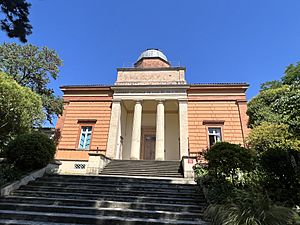Académie de l'air et de l'espace facts for kids
The Académie de l'air et de l'espace (which means Air and Space Academy in French, often called AAE) is France's special academy for everything about air and space. It was started in Toulouse in 1983 by André Turcat. The main goals of the AAE are to help develop great scientific, technical, cultural, and human activities related to air and space. It also wants to share knowledge and be a central place for these activities. Its members are people from all parts of the aerospace world, like pilots, astronauts, scientists, engineers, doctors, and even artists. They all work together to achieve these important goals.
The current president of the AAE is Gerard Brachet.
Contents
The Story of the Air and Space Academy
How the Idea Started
The idea for an air academy began way back in 1954. Colonel Edmond Petit, who worked for the French Air Force, wrote many articles about it. He thought France needed an academy just for aviation. He believed it should be a place to write about air history. He also felt it was important for French texts on aeronautics.
Creating the Academy
This big idea finally came true in 1983. André Turcat, a famous test pilot for the Concorde airplane, helped make it happen. His strong reputation in French aviation and with the city of Toulouse was key. The city of Toulouse, also known as "La Ville Rose," provided support. This allowed the academy to be set up at the old Jolimont observatory.
On November 21, 1983, thirty-five founding members met for the first time. This was also the 100th anniversary of the first human flight. The academy was officially recognized as a public service in 1987. Its main goals are to encourage high-quality work in air and space. It also aims to spread knowledge and be a central hub for these activities.
Global Connections
The academy organizes international meetings and discussions. It also puts on exhibitions and gives out awards. These awards honor people who have made important contributions to air and space. Every two or three months, it publishes "The Letter of the Academy." This letter shares information on important aviation topics. The academy also publishes larger works as papers or books.
The Air and Space Academy has sixty French members. It also has thirty foreign members. There are honorary members, who are pioneers in aviation and space. Correspondents help keep the academy connected to current aerospace activities. Members become honorary at age 75 or if they ask to. They can still take part in the academy's work if they wish.
Members can join different sections based on their special skills. These five areas are:
- Scientific knowledge of air and space
- Applied sciences and technology of air and space
- Human presence and activities in air and space
- Ethics, law, sociology, and economics of air and and space
- History, literature, and arts of air and space
Committees can also be formed to work on current issues. This happens when a member requests it. In 2007, the academy officially changed its name to "Air and Space Academy."
See also
 In Spanish: Academia del aire y del espacio para niños
In Spanish: Academia del aire y del espacio para niños


